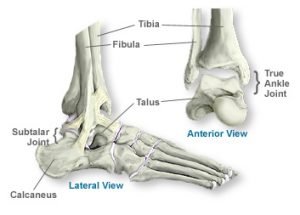Hindfoot Fusion
 Composed of two of the 7 tarsal bones, the talus and the calcaneus make up the hindfoot. The hindfoot connects the midfoot to the ankle and sits directly inferior to the ankle joint. Patients suffering from pain and stiffness due to arthritis, deformity, or repetitive injury may consider undergoing a Hindfoot Fusion. When seeking a physician to perform a Hindfoot Fusion, patients should look for board certified foot and ankle orthopedic specialists.
Composed of two of the 7 tarsal bones, the talus and the calcaneus make up the hindfoot. The hindfoot connects the midfoot to the ankle and sits directly inferior to the ankle joint. Patients suffering from pain and stiffness due to arthritis, deformity, or repetitive injury may consider undergoing a Hindfoot Fusion. When seeking a physician to perform a Hindfoot Fusion, patients should look for board certified foot and ankle orthopedic specialists.
How do foot and ankle surgeons perform a hindfoot fusion?
During Hindfoot Fusion, the anesthesiologist places the patient under general anesthesia. With a patient under general anesthesia the patient remains asleep throughout the entire procedure and does not awaken until the end of the procedure. The surgeon first cleans the surgical area with an anti-microbial wash. Next, the surgeon makes an incision into the lateral aspect of the foot and compresses the affected joints with specialized Hindfoot Fusion screws. Typically, only the subtalar joint needs fusing; however, if the patient has widespread arthritis or excess poor foot alignment, the calcaneocuboid joint and the talonavicular joint may also need fusing. To fuse those two joints, the surgeon makes an incision on the medial aspect of the foot. If a surgeon fuses all three joints, surgeons call it a “triple arthrodesis”. A Hindfoot Fusion screw allows the joints to fuse together creating one solid bone. With one solid bone, the joint no longer moves which diminishes the patient’s pain of the moving arthritic joint rubbing together. When an arthritic joint rubs together with movement, it creates painful friction. Once the foot and ankle surgeon completes their work, they close the wound and that completes the procedure.
The Hindfoot Fusion screw must stay in for a minimum of six months, but surgeons can remove a Hindfoot Fusion screw in a relatively quick procedure if the screw causes the patient too much pain or discomfort.
POTENTIAL RISKS AND COMPLICATIONS ASSOCIATED with MIDFOOT FUSION
Potential risks may arise any time something punctures the skin. During a Hindfoot Fusion, potential risks include those associated with anesthesia, infection, excessive bleeding, blood clots, and nerve damage. Surgery specific potential risks include the failure of the bones to fuse, over or under correction of deformity, or issues with the screws used.
If a patient suspects they may have any of these previous listed risks, they must let their provider know immediately.
To view a list of all insurances that AOA Orthopedic Specialists accept, click HERE. To schedule an appointment online, click HERE.
STUBBORN FOOT PAIN? CALL 817-375-5200 TO SCHEDULE AN APPOINTMENT WITH A FOOT AND ANKLE SPECIALIST TODAY!
F.A.Q.
What is Hindfoot Fusion, and how does it help with orthopedic conditions?
Hindfoot Fusion is a surgical procedure designed to treat various orthopedic conditions affecting the hindfoot region of the foot and ankle. This procedure involves the fusion of bones in the hindfoot to improve stability, alleviate pain, and correct deformities. By eliminating motion between specific bones, Hindfoot Fusion can effectively address conditions such as arthritis, deformities, and severe injuries in the hindfoot. Our skilled orthopedic surgeons at AOA Arlington Orthopedics specialize in Hindfoot Fusion to provide relief and restore function to patients with hindfoot-related issues.
Who is a Candidate for Hindfoot Fusion?
The eligibility for Hindfoot Fusion surgery depends on the individual’s specific condition and its severity. Typically, candidates for Hindfoot Fusion may include patients with severe hindfoot arthritis, hindfoot deformities, fractures that disrupt the stability of the hindfoot, or failed previous surgeries. It is essential to consult with our experienced orthopedic specialists at AOA Arlington Orthopedics for a thorough evaluation and personalized assessment to determine if Hindfoot Fusion is the right treatment option for you.
What is the Recovery Process After Hindfoot Fusion Surgery?
The recovery process after Hindfoot Fusion surgery varies depending on the extent of the procedure and the patient’s overall health. Generally, patients can expect a period of immobilization with the use of a cast or brace to support the healing process. Physical therapy may also be recommended to aid in rehabilitation and regain strength and mobility. It’s crucial to follow the post-operative instructions provided by our orthopedic team at AOA Arlington Orthopedics diligently. The complete recovery timeline can vary but usually ranges from several weeks to several months, and our experts will monitor your progress to ensure the best possible outcome.

